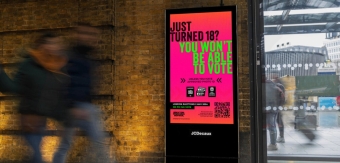Comedy is a funny thing (naturally). For one thing, it’s incredibly subjective. Indeed, one person’s lol can be another person’s lawsuit. When it comes to humour in advertising, this means there’s an even finer line to tread because an ad that amuses and inspires half the audience could turn the other half against you.
However, comedy can, and often does, manage to coexist with meaningful messages, enhancing rather than detracting from their impact and running the point home without lapsing into farce. Comedy has, after all, been a historically powerful tool for social commentary and societal change, and this arguably extends into adland.
By using humour, brands can engage audiences in ways that traditional, serious messages might not. Ads can tackle critical social issues, foster positive emotional connections, and make difficult subjects more approachable without alienating viewers. It’s not easy but it can and has been done before and will be done again, even in such a polarising age where cancel culture is rife.
Balancing humour and seriousness is not a new concept, of course. Tragicomedy, or “dramedy) is an approach that blends high and low plot structures, reflecting the complexities of real life, making narratives more relatable. Consider how some ads might use comedic elements to address serious topics.
For example, Budweiser revamped its iconic "Whassup" campaign to promote mental health awareness during the COVID-19 pandemic. The humorous format, familiar to audiences, was used to check in on friends’ well-being, blending comedy with a significant purpose. This technique makes the serious content more accessible and engaging for audiences using a familiar idea and giving it a more serious slant without losing the humour behind it.
A more recent example is Nationwide’s recent ad campaign, which used comedy to differentiate itself from competitors by showcasing a fictional rival bank’s extreme cost-cutting measures, like closing branches. This approach allowed Nationwide to highlight its commitment to customer service in a memorable and engaging way, even though one version of the campaign was eventually pulled for being misleading.
Funnily enough, however, that same ad was banned last month, as it’s claims that Nationwide had not been closing any branches were found to be demonstrably false. If anything, this highlights that fine line all brands and agencies should tread with caution when using humour in their ads.
Taco Bell's “Nacho Fries” campaign is another decent example, using a mock dramatic tone to address serious business challenges. In one ad, they humorously framed the return of nacho fries as a global event, poking fun at corporate marketing tactics while still promoting their product.
What most of these ads have in common (besides perhaps the Nationwide ad), however, is that they are all playing it pretty safe. The best comedy always offends someone and while the ads above are perfectly chuckle worthy, they’re never going to split anyone’s sides.
Ultimately, humour in advertising is, nine times out of ten, more about hooking into irony and satire. These are ideal tools for highlighting the absurdity of certain situations, making audiences think critically about the issues presented. For instance, every insurance company under the sun has used satire to poke fun at the unpredictability of life, ultimately emphasising the importance of being insured.
The primary purpose of comedy is to amuse, but it also has a corrective function. By holding a mirror up to society to reflect its follies and vices, comedy can provoke thought and discussion. This dual purpose allows advertisements to entertain while also delivering impactful messages.
Comedy’s ability to engage and connect with audiences makes it an ideal vehicle for conveying important messages. Whether through dramedy, satirical works, or light-hearted takes on serious issues, humour can enhance the impact of serious themes, making them more relatable and accessible.
But can there ever be a purposeful funny ad that’s actually legitimately funny? Who knows, but I for one would love to see it!




